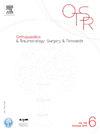双远端锁定是否能降低肱骨干骨折髓内钉的不愈合率?
IF 2.3
3区 医学
Q2 ORTHOPEDICS
引用次数: 0
摘要
简介髓内钉是治疗肱骨轴骨折的手术方法之一。不愈合是一种常见的并发症,发生率为 10-20%。本研究旨在比较采用双远端锁定、单远端锁定或无锁定髓内钉治疗的肱骨轴骨折的不愈合情况:材料和方法:这是一项单中心回顾性比较研究:这项单中心回顾性对比研究纳入了87例接受前行髓内钉治疗的无神经功能缺损的闭合性肱骨干骨折患者:第一组(双锁定)15例骨折;第二组(单锁定)2例骨折:15例骨折;第2组(单锁):63例骨折;第3组(无锁定):3例骨折:63处骨折;第3组(无锁定):9处骨折:9处骨折。未愈合的定义为 6 个月后影像学上无胼胝,且无临床疼痛。主要终点是每组的非愈合率。次要终点是6个月时的Constant评分和术后非甾体抗炎药(NSAIDs)的使用情况:非愈合率无明显差异:第一组为 20.0%,第二组为 20.3%,第三组为 0%(P = 0.32)。三组在 6 个月时的恒定评分有明显差异(P = 0.01)。第二组比其他组使用更多的非甾体抗炎药(39.1% vs 20.0% in group 1 and 33.3% in group 3; p = 0.37):讨论:髓内钉治疗无神经功能缺损的闭合性肱骨干骨折时,无论远端锁定与否,非愈合率都相似。尽管如此,双锁定组患者在6个月后的Constant评分更高,这可能与固定的稳定性更高有关,从而使康复更有效率:证据等级:III;回顾性比较研究。本文章由计算机程序翻译,如有差异,请以英文原文为准。
Does double distal locking reduce non-union rates in intramedullary nailing for humeral shaft fracture?
Introduction
Intramedullary nailing is one of the surgical treatments for humeral shaft fracture. Non-union is a common complication, with rates of 10–20%. The objective of this study was to compare non-union in humeral shaft fractures treated by intramedullary nailing with double distal locking, single distal locking or no locking.
Hypothesis
Nailing with double distal locking decreases non-union rates compared to single or no locking.
Material and methods
This single-center retrospective comparative study included 87 patients with closed humeral shaft fracture without neurologic deficit treated by anterograde intramedullary nailing: group 1 (double locking): 15 fractures; group 2 (single locking): 63 fractures; group 3 (no locking): 9 fractures. Non-union was defined as absence of radiographic callus at 6 months without clinical pain. The primary endpoint was non-union rate per group. The secondary endpoints were Constant score at 6 months, and postoperative use of non-steroidal anti-inflammatory drugs (NSAIDs).
Results
There were no significant differences in non-union rate: 20.0% in group 1, 20.3% in group 2, and 0% in group 3 (p = 0.32). Constant score at 6 months was significantly different between the 3 groups (p = 0.01). Group 2 used more NSAIDs than the other groups (39.1% vs. 20.0% in group 1 and 33.3% in group 3; p = 0.37).
Discussion
Non-union rates were similar regardless of distal locking for closed humeral shaft fractures without neurologic deficit treated by intramedullary nailing. Nevertheless, patients in the double locking group had higher Constant scores at 6 months, probably related to greater stability of fixation, allowing more efficient rehabilitation.
Level of evidence
III; retrospective comparative study.
求助全文
通过发布文献求助,成功后即可免费获取论文全文。
去求助
来源期刊
CiteScore
5.10
自引率
26.10%
发文量
329
审稿时长
12.5 weeks
期刊介绍:
Orthopaedics & Traumatology: Surgery & Research (OTSR) publishes original scientific work in English related to all domains of orthopaedics. Original articles, Reviews, Technical notes and Concise follow-up of a former OTSR study are published in English in electronic form only and indexed in the main international databases.

 求助内容:
求助内容: 应助结果提醒方式:
应助结果提醒方式:


